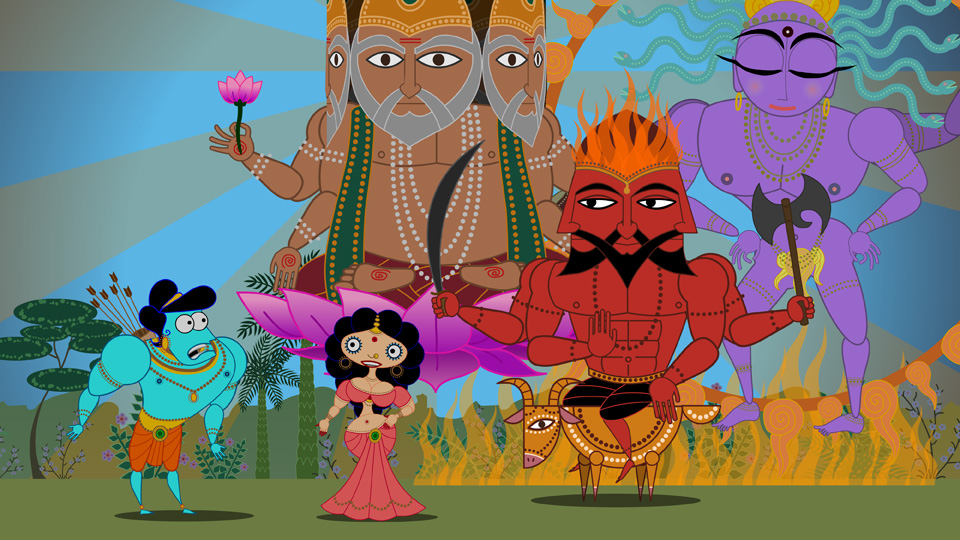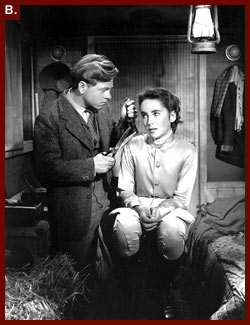Nina Paley, who bills herself as “America’s best-loved unknown cartoonist” is the artist/writer/director behind a smart, funny, visually stunning new animated film called “Sita Sings the Blues.” Paley’s cartoons include “Fluff” (Universal Press Syndicate), “The Hots” (King Features), and her own alternative weekly “Nina’s Adventures.” She animated and produced “Sita Sings the Blues” single-handedly on a home computer. Nina teaches at Parsons School of Design in Manhattan and is a 2006 Guggenheim Fellow.
“Sita Sings the Blues” is a multi-level presentation of the traditional Indian Ramayana saga that includes three different artistic styles, a modern-day parallel based on Paley’s own life, and the songs of 1920’s-30’s nightclub singer Annette Hanshaw. I met Paley two years ago at a reception for women film-makers. We talked briefly about her work on this film and she gave me a business card with a small drawing of Sita. I was delighted to see the film at Tribeca this year and glad to have a chance to interview Paley via email.
What first interested you in the Ramayana saga?
I was living in Triuavndrum, India, where I read it for the first time.
There are at least four different graphic styles in the way the characters in your film are
presented. How would you describe them and what does each one add to the story?
the smooth cartoony style for the Hanshaw numbers, the shadow puppets with collage characters in the background, during the unscripted dialog, the fake miniature Mughal paintings, during the scripted dialog, the expressionistic rotoscoped scene just after the
“intermission.” Each style refers to a different art tradition associated with the Ramayana, and lends itself to the shifting narrative styles as well

The narration of the Ramayana story feels very improvised — how did that come about?
It was improvised.
Who are the narrators?
Friends from India, see here.
Is their contradiction of each other and refinement of each other’s versions intended to match the mix of artistic styles in the visuals?
It’s very natural. They’re all from different regions of India and speak different mother tongues, and grew up on different versions of the story. So naturally they remember “the” Ramayana differently from one another. There is no one Ramayana. Their discussion makes this clear.
Why combine the Ramayana story with the modern-day parallel? In some ways, the stories are very different.
Yes, my story doesn’t involve demons, magic arrows, palace intrigue, or purity. But both stories are about heartbreak, and a peculiar relationship dynamic between a man and a woman, and that’s the aspect of both I emphasized. It’s also what they have in common with the Blues.
How did you select 1920’s chanteuse Annette Hanshaw as the singing voice of Sita?
See here.
Do you think that women directors bring a distinctive perspective and if so, how would you describe it? How would this story be different if told by a man? Or would a man not tell this story?
This story was told by me as an individual. An individual brings their individual characteristics and experience to a story. I happen to be a woman, but I’m a specific woman, not womankind in general. I can’t tell you how other women would direct a particular film, or other men. We’re all unique.
I will say that there are distinctive womens’ tellings of the Ramayana that differ greatly from mainstream (men’s) versions.
In the novel “Heartburn,” Nora Ephron said that she wrote it even though it had some material that embarrassed her because it allowed her to control the story. Would you say that is true for you with this movie? Did you find it validating or vindicating?
I found it therapeutic.
What are you working on next? More animation or will you do live-action as well?
The Muse hasn’t given me my next orders yet, which is good, because I have to be a fulltime producer for “Sita” right now.
What are the distribution plans for the film? Where can people see it?
Watch “Sita Sings the Blues” for free online.
Who are some of your influences in animation and in comics?
Everything I’ve ever seen!

 Lionsgate/HIT Entertainment announce a new narrator for this fall’s upcoming feature-length Thomas the Tank Engine DVD release, “Thomas & Friends: The Great Discovery.” Following the wonderful voiceover work from Ringo Starr, George Carlin, and Alec Baldwin is this
Lionsgate/HIT Entertainment announce a new narrator for this fall’s upcoming feature-length Thomas the Tank Engine DVD release, “Thomas & Friends: The Great Discovery.” Following the wonderful voiceover work from Ringo Starr, George Carlin, and Alec Baldwin is this 
